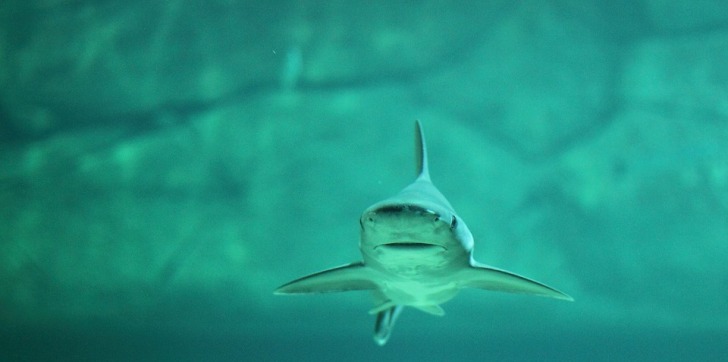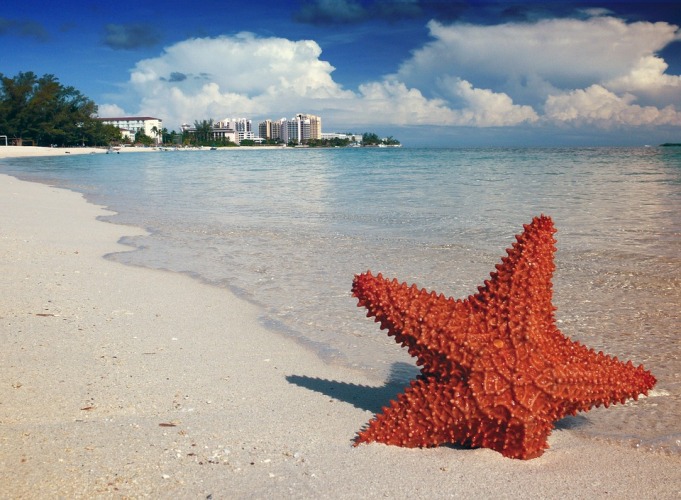Are you contemplating visiting The Bahamas, but are holding back because of your fear of sharks?
Then you are in the right place.
This post will let you know all about sharks in the Bahamas.
It will tell you all about the types of sharks there are, what types of water sharks prefer, and how to act if you encounter a shark while swimming in the Bahamas.
Sharks are misunderstood and have a bad reputation due to pop culture shows like Shark Week.
It is not fair to judge sharks based on what the media tells us.
Injuries and fatalities involving sharks are very infrequent.
Contents
- So… Are There Sharks in The Bahamas?
- Six Shark Species Are Located in The Bahamas
- Is it Safe to Swim in The Bahamas?
- Interesting Shark Facts in The Bahamas
- Sharks in Freshwater vs. Sharks in Saltwater
- Three Safety Tips for Swimming in Shark-Infested Waters
- Summary
- Sources
- Going to The Bahamas?
- The Bahamas Safety Overview
- Frequently Asked Questions
So… Are There Sharks in The Bahamas?
Yes, there are sharks in the Bahamas.
Sharks and other dangerous fish are known to roam the waters of the tropical oasis.
In the Bahamas, you will find over forty different species of sharks.
Sharks can be found in the 243,000 square miles of water.
Because of a 2011 ban on shark fishing, the waters are more populated with sharks than ever.
The Bahamas is known for its many miles of sandy beaches.
If you love sharks or are a shark fanatic, you definitely want to visit the Bahamas.
The sharks in the Bahamas are not the scary killing machines that people believe.
Sharks are simply inquisitive animals who wish to investigate the sea, just like you do.

Six Shark Species Are Located in The Bahamas
Bull Shark
Bull Sharks prefer shallow water.
Out of all the species on this list, the bull shark is the most unpredictable and aggressive.
They are responsible for the majority of the shark-related fatalities in the Bahamas.
They have short, blunt noses and thick bodies.
Lemon Sharks
You will find Lemon Sharks in shallow water.
They tend to stick to protected areas like river mouths, bays, and coral reefs.
The Lemon Shark has a yellow-gray complexion.
Their underside is a pale yellow color.
Tiger Sharks
Tiger Sharks are known as the dumpster of the sea.
These sharks will eat anything.
A Tiger Shark was once found with a tire in its stomach.
As the fourth largest shark in the world, the Tiger Shark is recognizable for its distinctive gray vertical stripes and spots.
Caribbean Reef Shark
The Caribbean Reef Shark is a dusky-colored shark.
It is best known for its large, saucer-sized eyes.
Once commonly found in the oceans of the Bahamas, the Caribbean Reef Shark is now in danger.
Due to the many years of overfishing, the Caribbean Reef Shark has become endangered.
Sharks are sought after for leather products, liver oil, and fishmeal.
Oceanic Whitetip
These sharks were once endangered.
Now they are thriving in the protected waters of the Bahamas.
They are large-bodied sharks that have a unique pattern on their skin.
The Oceanic Whitetip shark has rounded dorsal fins and long, paddle-like pectoral fins.
Silky Shark
The Silky Shark is named because of its smooth skin.
This velvety shark has many different names.
- Gray Whaler Shark
- Sickle Shaped Shark
- Sickle Silk Shark
- Sickle Shark
- Olive Shark
- Blackspot Shark
- Ridgeback Shark

Is it Safe to Swim in The Bahamas?
Yes, it is safe to swim in the Bahamas.
Shark attacks are sporadic and do not happen as often as movies and television have led us to believe.
The majority of the beaches will have flags denoting where it is safe for you to swim.
Swimming past the flags is not advisable as you may get pulled out to see due to riptide.
Many beaches have strong currents so pay attention to the flags at all times.
Night swimming is not recommended because it will be harder to see what is going on around you in the ocean.
Also, sharks have excellent eyesight and will see you clearly in the sea even if you cannot see them.
Barracudas are large fish found in the waters of the Bahamas.
You can also find stingrays in these waters.
Generally, sea life will not bother you as you swim.
Fresh blood is attractive to sharks, so avoid swimming if you have open wounds.
Interesting Shark Facts in The Bahamas
Sharks are a prevalent animal to study.
Not only are they stunning to look at, but they are also fascinating to learn about.
These apex predators are engrossed in people.
Here are some intriguing, fun facts concerning sharks in the Bahamas:
- During the daylight hours, dozens of Nurse Sharks pile on top of one another on the ocean floor.
- Sharks do not have any bones. They are still able to fossilize, though, due to calcium deposits.
- Most sharks have excellent eyesight. They will be able to see well, even in the darkest depths of the ocean. That is why night swimming is not recommended in the Bahamas. Sharks can see exceptionally well at night.
- Besides the Silky Shark, most of the sharks in the Bahama’s skin feel like sandpaper. Tiny tooth-like structures make up their skin. They are there to reduce friction from water as the shark swims.
- Sharks have been around for a very long time. They date back to at least 455 million years ago.
- Hammerhead sharks have 360-degree vision. Due to the location of their eyes, these unique sharks can see all around the ocean floor.
- Pregnancies last for about two years in female sharks.
- The Megalodon was the largest shark ever to live. They also survived four out of five mass extinctions.
- A shark will lose 35,000 teeth in its lifetime.
- Sharks are vital to reef conservation. Reefs seem to be healthier in areas with a high shark population.
- Not all sharks sleep. Some shark species need to swim continuously, but that is not true for all sharks.
- The largest shark and the largest fish in the ocean is the Whale shark. Whale Sharks can reach up to sixty feet.
- The Dwarf Lanternshark can be found in the Caribbean Sea. They are the smallest shark and reach maturity at eight inches.
- Sharks are opportunistic feeders but primarily feed on invertebrates and smaller fish. A shark will eat plankton, squid, and octopus.
- Sharks go to the bathroom as every other animal does. Researchers actually love to examine the shark’s poop because it gives you insight into what a shark has eaten.
- There are over five hundred types of sharks globally.
- The shark awareness day is July 14.
- Baby sharks swim away from their mother once they are born to avoid being eaten by their mom.
- Millions of sharks are killed by humans each year.
- At least one species of shark is found in every ocean. Even the Arctic Ocean has sharks.

Sharks can only handle saltwater, not freshwater.
You will not find a shark in a freshwater lake or river.
Even though they are cold-blooded, they do not just seek out cold water.
Many sharks live in the tropics and warm water.
These predators want to be well hidden from their prey, so they live in deep ocean areas.
Even though they prefer deeper waters, numerous sharks will swim closer to the surface to find food sources.
Sharks prefer temperatures between fifty-nine degrees Fahrenheit and eighty degrees Fahrenheit.
However, there are sharks who live in the Arctic and swim in subzero-temperature water.
In The Bahamas, the water temperature rarely reaches below the seventy-two degrees Fahrenheit mark.
Three Safety Tips for Swimming in Shark-Infested Waters
Encountering a shark while you are swimming is a terrifying experience.
Follow these three safety tips if you ever come face to face with one of these apex predators.
First and foremost, you need to create space between you and the shark.
Do not swim away as fast as you can because the shark will mistake you for prey.
Show the shark that you are aware that the shark is there by looking them directly in the eye.
Quickly scan the water to ensure no other sharks are in the area.
Most people assume if a shark is nearby, they would know, but that is not the truth.
There are sharks around you in the ocean all the time as you swim; you just are not aware of them.
Sharks are curious creatures who usually want to check out what is happening.
If a shark approaches you in a rare moment, then stay calm.
The most important tip of all is to remain calm and not panic.
You have to act like a predator yourself, or the shark may mistake you for food.
Do not draw attention to yourself because the shark will not see you as a threat.
Stay calm, make eye contact, and slowly back away from the shark to ensure your safety.
Summary
Sharks are beautiful creatures who have a terrible reputation because of movies like Jaws.
Shark attacks are not as common as you may think.
Yes, there are sharks in the Bahamas, but if you do not mess with them, chances are they will not mess with you.
In 2011, the Bahamas issued a ban on shark fishing, helping the shark population increase.
Many sharks who were once endangered are now seen in expansive amounts.
If you encounter any of the many species of sharks who reside in the oceans of the Bahamas, stay subdued.
Pretend to be an ocean predator and make eye contact with the shark.
Slowly back away, being careful not to splash or cause a scene.
If the shark mistakes you for prey, the situation could turn serious in a minute.
Sources
- https://www.floridamuseum.ufl.edu/discover-fish/sharks/faq/
- https://www.fisheries.noaa.gov/feature-story/12-shark-facts-may-surprise-you
- https://www.sea.museum/2020/01/16/ten-interesting-facts-about-sharks
- https://masterliveaboards.com/diving-with-sharks-in-the-bahamas/
- https://www.bluewaterdivetravel.com/bahamas-shark-diving
Going to The Bahamas?
That’s awesome!
It’s a great travel destination.
But before all the fun, as with anywhere else, there are dangers and it’s good to be aware.
Here’s our safety report:
The Bahamas Safety Overview
READ THE FULL REPORT: The Bahamas Safety Review
Safety Index:
- OVERALL RISK: HIGH
- TRANSPORT & TAXIS RISK: MEDIUM
- PICKPOCKETS RISK: HIGH
- NATURAL DISASTERS RISK: MEDIUM
- MUGGING RISK: HIGH
- TERRORISM RISK: LOW
- SCAMS RISK: MEDIUM
- WOMEN TRAVELERS RISK: MEDIUM
Frequently Asked Questions
How long do sharks live?
It depends on the species of the shark.
Some sharks live for sixteen years, but others have lived for fifty years.
The Greenland shark is estimated to live for approximately four hundred years.
Can sharks hear?
Sharks have an impeccable sense of hearing.
Unlike humans, who have ears on the outside of their head, the shark has two ears on its head’s interior.
Their excellent sense of hearing helps them to locate prey far away.
They can also pick up on vibrations with their great hearing skills.
What is the fastest shark?
The fastest shark is the Shortfin Mako.
This shark can reach speeds of up to forty-three miles per hour.
It chases down some of the fastest fishes in the ocean, like tuna and swordfish.












Yeah their not dangerous just ask the mid that jumped off blackbeard!Sharks attack people!They should be protected but they are dangerous!No kumbai here!!!!
As someone who has visited the Bahamas, I can say that there are indeed sharks in the waters.
However, shark attacks and encounters are rare and should not deter you from visiting this beautiful destination.